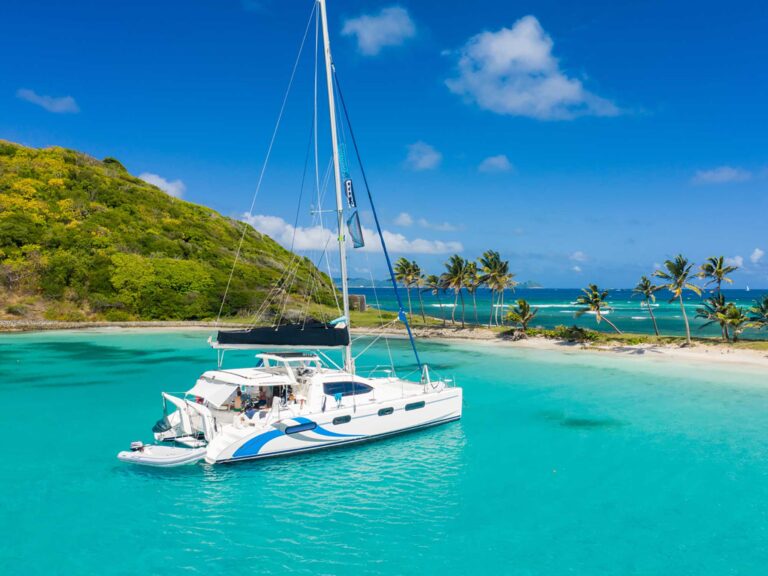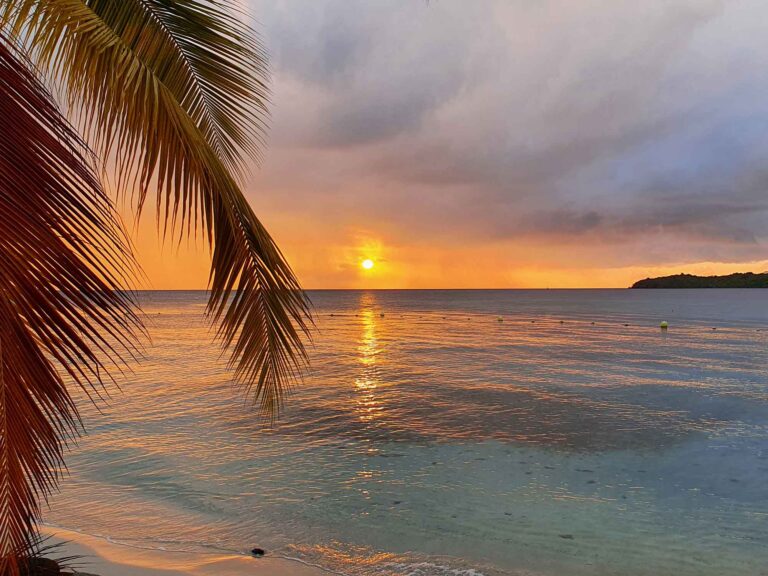Finally the boat! And repairs…
So, it’s been a few weeks since the last post and lots has happened since then.
I do apologize for not giving news more often, but let me tell you everything that has happened since.
The boat
First of all, we bought a boat.

A Lagoon 440 from 2007. It was the first boat we visited when we arrived. The boat was in such a good structural condition that it went straight to the top of the list of boats to be considered. It is clean, in very good condition given its age, and is of a very good construction quality.
The more recent versions of this boat (the Lagoon 450 F and 450 S), are more “bulky”, have more structural problems because Lagoon’s construction methods and processes changed around the 2010s. And they haven’t changed in a good way. They’ve evolved toward an “IKEA-ization” of the production processes and quality.
The Lagoon 440 is of the more “ancient” construction style and still has a more sea-oriented design with hulls that are narrower by design, and therefore, glide better through the water. The overall build quality is just better than the newer models.

We bought the boat in January 2021 after a particularly thorough survey by Safety First and Mécanique Plaisance. Then, we waited patiently for all the paperwork to get cleared, to get the new ownership titles with the new name, and to move onboard.
Which we finally did on February 2nd.
The tradeoffs
Of course, there are tradeoffs with every boat and every navigation program. This particular boat has a flybridge (ie, the steering wheel is on top of the roof of the catamaran, instead of inside the cockpit), which has its advantages and its drawbacks.
The main advantages of the flybridge are:
- An extremely good visibility when cruising along the shorelines, where local fishermen tend to set lobster and fish traps. These traps, when caught in the propellers, can be extremely harmful to a boat. From the flybridge, you can see the traps from very far away and have ample time to plot an avoidance course, especially at dusk when the traps are difficult to see from sea-level
- It provides a third “living” area. The other areas are the cockpit and the saloon, which can be found on traditional catamarans. The flybridge provides an extra area where you can sit and relax and enjoy the night skies.
- Sailing from the flybridge, in the Caribbean, is fantastic. We have an extraordinary 360 degree vision around us. We can see boats, dolphins, turtles and almost anything that floats or swims from quite far away. Whereas from traditional catamarans you need to be “nose on the fish” to see it.

There are some major drawbacks, of course:
- You’re always exposed to the weather on the flybridge. Whereas on an enclosed helm position, the skipper can just relax and sit back if it rains a bit, on a boat with a flybridge, you either get wet, or you take refuge inside the saloon (the auto-pilot of the boat can be controlled from the saloon).
- You sit very high up and the boom is even higher. In rough seas, sitting higher up means a higher rotation point, which can lead to discomfort (I haven’t experienced it yet, even though we went through some fairly heavy weather).
- The main drawback is the higher boom though. The flybridge means you need to have extra headroom, and thus the boom is placed higher. At anchorage, climbing up to the boom and checking the sail isn’t a problem. However, in rougher seas, this might become a bit of a challenge.

All in all though, now that we have sailed with our boat, have encountered our first problems, and our first squalls, I mush admit that I am happy with it. But most importantly though, the rest of the family are thoroughly happy with it and we feel safe on the boat.
The repairs
Even though the boat was in very good condition, it wasn’t in PRISTINE condition. Quite a lot of systems needed maintenance and, in some cases, a major overhaul.
I mean, right from the start, on the first day, one of our fridges stopped working… I think it was the boat’s way of telling me: “show me some love and get started on those repairs”. The fix was actually quite quick, just removing the excess dust of the ventilators and the fan did the trick. But still, it was a sign of the things to come.
Engines
For example, the engines. Although they had been maintained pretty well, the previous owner was more of a “pontoon skipper”. He had a space at the pontoon at Le Marin all year round, and spent most of his time at the marina. They’d go for a sail only occasionally. Also, they’d leave the boat for 6 months at the pontoon and would go back to France for work.
This, of course, is not ideal for the engines. They needed a very thorough overhaul, but are extremely tough. Given their age (they are almost at mid-life at 4500 hours), they’re sturdy, in good condition (now that the overhaul has happened), and will keep us safe for quite some time still.


Windlass
Another piece of repair was the windlass. Even though the previous owner had done some (very) basic maintenance on it, when I tried to put in some real maintenance work and completely take it apart, it was actually completely stuck due to corrosion.
It took me 2 weeks to remove it and install a new windlass.

I had to cut out the old windlass because all screws had corroded stuck or broken off due to corrosion. Then, I had to fill the holes from the old windlass, do some fiberglass work, cut out new holes, apply a new gelcoat and mount the new windlass.
The fiberglass and gelcoat work did take me the better part of 6 days. But I am quite happy with the results.

The only thing remaining on the new windlass is to build a fiberglass piece to protect the electrical connections, since the old windlass had a little housing, where the new windlass doesn’t.
Watermaker
Another major piece of work was the watermaker. The boat had on board a 50 liter/hour watermaker that was installed quite a while back. The previous owner had regularly done some maintenance work on the watermaker, but his work was mainly limited to changing the oil of the high pressure pump.
When I started taking apart the watermaker to do a serious maintenance, I realized that almost everything, from the electrical motor to the crank case to the structure, was rusty and corroded. So, I took the whole system apart and inspected and de-rusted all mechanical parts of the watermaker.

Then, with Stephanie, we changed all the filters and repaired all the leaks in the system (from the water inlet to the water outlet). Lastly, I installed a tap at the sink and a valve that allows us to get clean and fresh water directly from the watermaker in the kitchen. Again, all this took another 2 or 3 weeks of intensive work.
Electronics
The autopilot had a tendency of shorting out, and loosing its bearings. It would shut down right in the middle of a navigation. So, again, I took it out completely, checked out all the wires, and rebuilt the electrical wiring. Finally, it works, but yet again, another week of work.
Also, I wanted to connect a computer to the onboard electrical circuitry, so as to be able to monitor our speed, heading and autopilot setting from any area of the boat with a tablet or a phone.
However, when I tried to connect a PC to the network bus present in the boat, everything fell apart and nothing seemed to work anymore. After researching the cause of the malfunction, it seems that my system is a “bit outdated” and not able to handle more that 3 connections on the data bus. Every time I tried to connect a fourth element (in this case a USB connection to the computer), some random equipment would shut down and the whole system would fail.
When checking with a specialist in Martinique, it seems that I can add a multiplexer and WiFi controller to the system, but there is a risk that these newer elements would not be compatible with the older system and crash the whole system. So, the saying “if it ain’t broke, don’t fix it” applies particularly well in this context, and for now, we’re not ready to invest the extra 10-15 kEUR to update our navigation system. Thus, no computer.
I bought the Navionics app for Android for some 30 EUR instead.
Plumbing and toilets
Most boats have a holding tank so as to stock human waste when at anchorage or in a harbour. So as not to make “friends” the wrong way with the neighboring boats.
The previous owner had completely disconnected (bypassed actually) the holding tank that had been factory installed. He couldn’t be bothered with the maintenance of this piece of plumbing, that although sturdy, is a nasty piece of work if it fails. And when I say nasty, I mean “DANG! That’s NASTY!!!!”.

So, I reconnected the holding tank to the toilet, and the outlet to the correct seacock. We’ve been “testing” the system for a while, and it seems that it is working as intended.
Circuitry, leaks and corrosion
When we took possession of the boat, we spent hours tracing all circuits, pipes, valves, inlets, outlets, taps, pumps and filters, so as to understand the circuitry of the boat. Every time we looked at something, we would find a leak (big or small), a corroded piece of plumbing, or an old pipe that was cracked. Every single time, we would analyze the criticality of the leak or corrosion, and start the repairs accordingly. Nothing major, but everything on a boat is just time consuming.
Everything else
The list of things to repair and maintain preemptively is just humongous and I can’t list all the work that we did on the boat. Suffice it to say that we spent 2 full months working day-in, day-out, 7 days a week (no real weekends), to get the boat ready to depart.
And now?
Our plan is to get out of the marina by end of March and start sailing the Caribbean. Mostly up to the northern part of the Caribbean, before the hurricane season sets in. Once the hurricane season sets in, we’ll explore the southern Caribbean.
More on that in a later post though.







